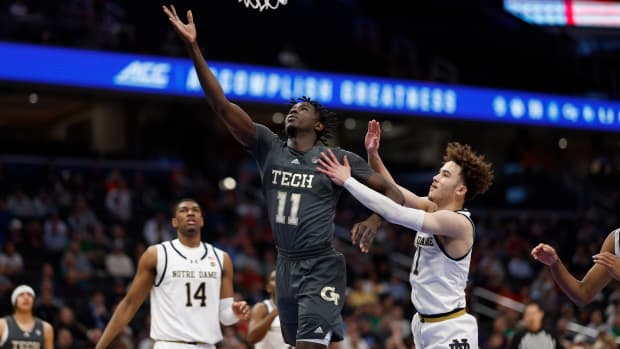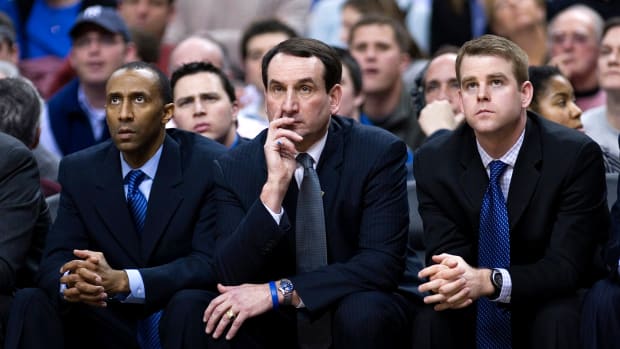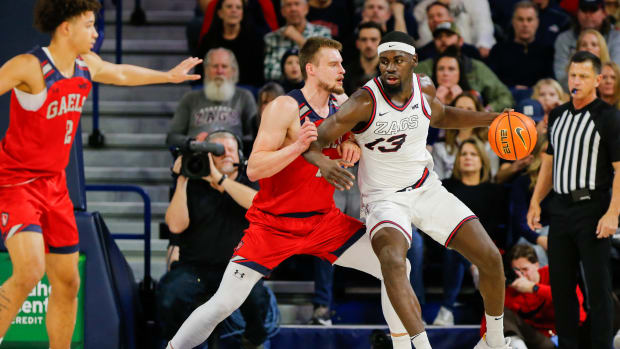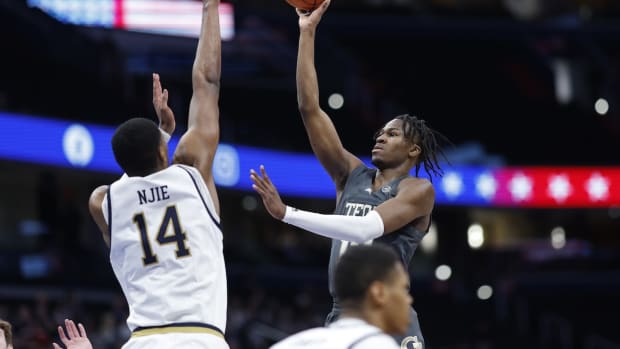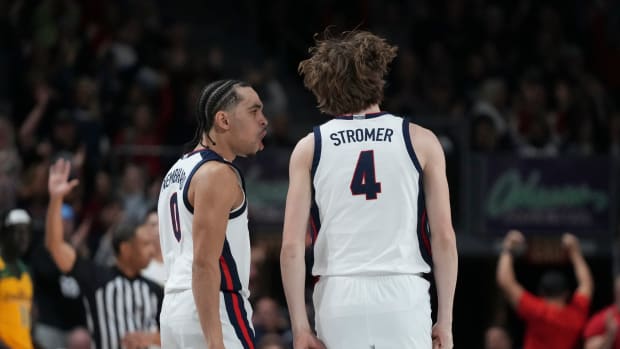Kentucky, Duke, Wisconsin lead post-draft declarations rankings
The post-draft-deadline and post-Myles Turner edition of the Power Rankings, which will stand until we reconvene in October:
1. Kentucky Wildcats
2. Duke Blue Devils
Add two inches to Sullinger's height and four inches onto his wingspan and you get Okafor, a Chicago product who should make a run at national player of the year honors and then be among the top three picks in the 2015 draft. With Okafor's talent and size -- and two quality point guards in freshman Tyus Jones and senior Quinn Cook feeding him the ball -- a high-efficiency, 17-point, 10-rebound season is well within his reach.
3. Wisconsin Badgers
Among returning players, senior Frank Kaminsky might be Okafor's chief competition for the Naismith and Wooden awards. The list of non-freshman candidates is pretty thin: All of the AP's first- and second-team All-Americas have moved on to the pros, and everyone who finished in the top 10 of the kPOY is gone too. Kaminsky is the best player back from the nation's best conference, and he was the most efficient major-conference post scorer in the country last year, according to Synergy. In an era where post play is becoming less and less prevalent, Kaminsky's work on the blocks (which can alternate between nimble and, as he's described it, "weird"), stands out:
4. Arizona Wildcats
Kadeem Allen, a junior college transfer from Hutchinson (Kans.) Community College, is Arizona's most intriguing newcomer. The Wildcats are badly in need of a dynamic backcourt scorer to replace Nick Johnson, and Allen, a 6-3 combo guard who was the national juco player of the year in 2013-14 and broke the 30-point mark 13 times, may be the answer. Although Allen wasn't a lights-out shooter at Hutch (making 30.5 percent of his threes), he excelled at driving to the rim and drawing fouls. Juco guards of his ilk -- ex-Baylor star Pierre Jackson, ex-Marquette guard Dwight Buycks and current Louisville point guard Chris Jones were similarly rated -- tend to provide instant value, and Allen's highlight reel should give you an idea of why Sean Miller and Bill Self made him a recruiting priority:
5. Kansas Jayhawks
Will Perry Ellis spend his entire college career being overshadowed in Kansas' frontcourt? When he arrived as a five-star freshman in 2012-13, he was a reserve on a front line that had the nation's best rim protecter in future first-round NBA draft pick Jeff Withey. Last season, Ellis was the Jayhawks' most efficient scorer, but he was in the middle of a 3-4-5 trio that also included small forward Andrew Wiggins and center Joel Embiid -- who may be the Nos. 1 and 2 picks in this June's draft. This season? Ellis returns as one of the country's most skilled offensive power forwards . . . but he's being joined by burly 6-9 freshman Cliff Alexander, whom DraftExpress projects as the No. 2 pick in 2015 . . . and 6-7 wing Kelly Oubre, who's projected as the No. 11 pick a year from now. Ellis isn't on draft boards because he's an undersized post, but I wouldn't be surprised if he leads KU in scoring as a junior.
6. North Carolina Tar Heels
Jackson is a slasher with great feel in the mid-range, and he shot 60.5 percent on twos and 40.5 percent on threes in the EYBL. He should be able to give Marcus Paige some scoring help on the wing.
7. Wichita State Shockers
Duke and Kentucky have the most depth, and SMU has the best pro prospect (Mudiay), but the Shockers' trio has the most experience (Cotton is a senior, the others are juniors) and plays the best defense. As long as they get adequate interior play from Darius Carter and whoever fills the other frontcourt spot, Wichita State will again be a top-10 team.
8. Louisville Cardinals
The issue I'm most curious about for next year's Cardinals is shot distribution. Russ Smith attempted team-high 481 field goals and 217 free throws last season, using 31.1 percent of Louisville's possessions. Power forward Montrezl Harrell made a surprising decision to return for his junior season; is that when he'll make the leap to go-to-guy after averaging just under 10 shots per game in '13-14? Or does combo guard Chris Jones get to fulfill the shoot-first urges he had to (partially) suppress while playing next to Smith last season? Or does sophomore combo guard Terry Rozier have a huge breakout year and become the Cards' featured scorer? My guess is that Rozier will play the role of stabilizer while Jones and Harrell both average 16-17 points per game. Harrell could easily get into the 20s if he starts making free throws, but his career percentage from the stripe is just 47.7.
9. Virginia Cavaliers
The Cavaliers seem well-positioned to deal with the losses of seniors Joe Harris (their best shooter) and Akil Mitchell (their best rebounder). In the backcourt, junior-to-be Malcolm Brogdon is an All-America candidate and perhaps the best rebounding guard in the ACC; London Perrantes had an extremely promising February and March while running the point as a true freshman and can take on a bigger scoring role next season. Forwards Anthony Gill and Mike Tobey, who both averaged less than 20 minutes/game as sophomores, can help make up for Mitchell's rebounding -- and Gill looks like he can emerge as a solid auxiliary scorer to Brogdon. Combine all that with the expectation that coach Tony Bennett will produce a top-10 defense, and you have a team that will have a realistic chance to defend its ACC regular season and tournament titles.
10. Texas Longhorns
(Screengrab source: ESPNU)
11. Florida Gators
If I had to break these rankings into tiers, I'd consider teams 1-5 as the prime national title contenders, 6-10 as the lesser contenders, and 11-and-beyond as the wild cards. How smooth will the Gators' transition be after losing four valuable senior starters? By putting them this high, I'm assuming that junior forward Dorian Finney-Smith and sophomore Chris Walker, who smartly passed on the NBA draft, will give opposing frontcourts problems with their offensive versatility. I'm less confident that sophomore point guard Kasey Hill can make up for Scottie Wilbekin's all-around value. Wilbekin was an elite defender and an adequate three-point shooter; Hill is still a work in progress as a defender and he couldn't make threes as a freshman. His last long-range make came on Jan. 23, and he finished the season 5-of-35 from deep. Having a point guard who isn't a shooting threat can really bog down an offense; just ask Marquette what happened this season with Derrick Wilson.
12. Villanova Wildcats
The Wildcats have a unique, ready-to-breakout player in 6-5 rising sophomore Josh Hart. His finishing ability around the basket is remarkable, as he shot 67.0 percent on his two-pointers as a freshman reserve and barely ever committed turnovers. He's also a fantastic, instinctual offensive rebounder; while many guards are content to only chase long boards, Hart loves to crash from the weak side or trail a driver to the rim and hunt for tip-ins. Here's an edit of his best putbacks, so you can see what I'm selling:
13. Southern Methodist Mustangs
The Mustangs have the opportunity to play two very good -- and very different -- point guards together in Emmanuel Mudiay and Nic Moore. Mudiay, who's projected to be the first guard off the board in the 2015 draft, is a 6-5 slasher who'll do most of his work off the bounce and draw plenty of fouls under the tighter-reffing rules. Moore was one of the country's most underrated point guards as a sophomore, when he had an assist/turnover ratio of 2.1-to-1 and shot 43.6 percent from long range. At 5-9 he's more of a distributor/shooter and should benefit from the drive-and-kick opportunities that Mudiay can create. The tandem should make SMU good enough to win the AAC and easily break through to its first NCAA tournament since 1993.
14. Iowa State Cyclones
(Chart source: Draftexpress.com. Minimum 20 minutes played per game to qualify.)
15. Ohio State Buckeyes
I think we're all curious to see how much the Buckeyes' defense slips in Year 1 After Craft, even though senior point guard Shannon Scott is a pest in his own right (his steal percentages beat Aaron Craft's for the past two seasons). Was Craft's impact on the team's overall defensive efficiency accurately portrayed? Over his four-year career, Ohio State's average national rank in adjusted defensive efficiency on kenpom.com was 9.5, while the average rank of Thad Matta's previous six Buckeyes teams was 27th. Even with the addition of five-star shooting guard D'Angelo Russell, their offense is likely to be middling in '14-15, so the only way they can challenge Wisconsin for the Big Ten title is with a top-10 defense.
16. Gonzaga Bulldogs
Gonzaga won't have the best frontcourt in the country next season, but it'll have the most wordly one, with 7-foot lefty Przemek Karnowski, the biggest Polish prospect to hit college hoops in maybe forever; 6-10 Canadian-American Kyle Wiltjer, a sharpshooter who was part of Kentucky's 2012 national title team before transferring aft erhte 2012-13 season; and the most recent addition, 6-10 Lithuanian Domantas Sabonis, the son of international hoops legend and former Portland Trail Blazer Arvydas Sabonis. Domantas is a lefty who's already been seasoned in the Spanish (pro) ACB with Unicaja, and although he's not on the same prospect level as his father was in the '80s or fellow Lithuanian power forward Jonas Valanciunas was in 2011, the youngest Sabonis should be a valuable rotation player in Year 1 and a potential star in Year 2.

